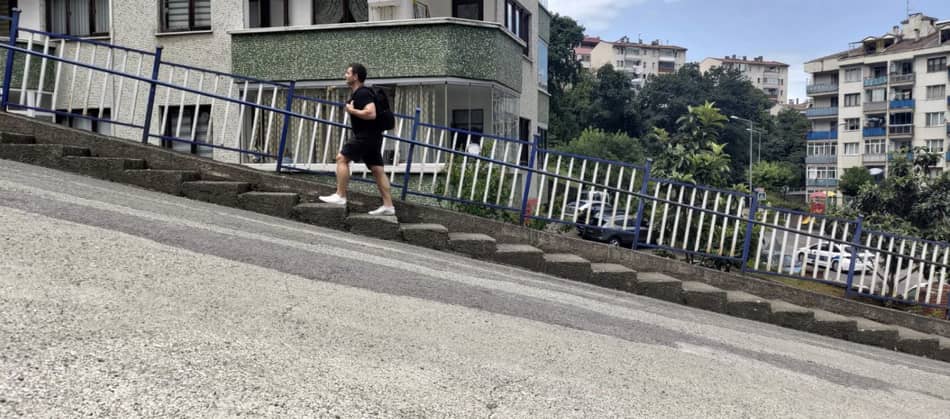
Peloton Walking refers to a series of Peloton Classes that include a range of low-impact workouts on the Peloton Tread, designed to enhance cardiovascular fitness and build endurance. Ideal for all fitness levels, Peloton Walking is all about spicing up your walk with workouts that last from 10 to 60 minutes. You’ve got everything from chill Warm Ups and Cool Downs to upbeat Music and Theme walks, and even Power Walks and Hikes to get your heart pumping.
Peloton walks offer numerous health benefits, including weight loss, lower blood pressure, and a reduced risk of chronic diseases. They’re great for boosting heart and lung fitness and can significantly decrease the risk of heart disease and stroke. Whether you’re in the mood for a light stroll or a more intense stride, Peloton instructors like Becs Gentry, Susie Chan, and Jess King have got your back. It’s easy to find these classes on the Peloton app, making walking way more than just a simple leg stretch.
This review aims to provide clarity on the best Peloton walking classes available, exploring the differences between treadmill walks and Peloton outdoor walks. It addresses whether Peloton walking can be done outside and highlights the top instructors for these classes. Additionally, the review covers the Peloton walking workout plan and how to engage in Peloton walking classes if you don’t have a treadmill.
What is Peloton Walking?
Peloton Walking is a type of Peloton workout with a variety of classes, both live and on-demand, with over 2,000 tread workouts across eight categories. Suitable for both indoor and outdoor activities, these classes can be performed with or without a treadmill and are accessible with all four types of Peloton memberships: Free, App+, App One, and All-Access. It’s like guided walking, where instructors explain the benefits of daily walks and keep you entertained.
Peloton Walking classes are known for their motivating music playlists and include effective warm-up and cool-down segments, making them great for calorie burning. Additionally, in-person walking classes are available in Peloton studios in NYC and London, and the platform offers scenic virtual routes for an immersive indoor walking experience. The best time to do Peloton walks depends on the type of class you choose. I prefer morning Power Walking when I need an energy boost, but I also enjoy late afternoon Strolling on my tread or evening calorie-burning sessions.
How do the Peloton Walking Classes work?
Peloton Walking Classes offer indoor walking workouts that are similar to fitness walking but without the need for step counting or pedometers. You can do these workouts at home with a Peloton Tread or any treadmill you prefer. The classes provide a great alternative to outdoor walks and come in various difficulty levels, with options like Walk + Run for marathon training and Hiking for uphill walking. The pace and music in these classes vary, and you can expect some stretching incorporated before or after the walks to enhance flexibility and recovery. Taking a Peloton Walking class, even when you’re walking solo, can provide a sense of community and make it feel like a group activity.
Peloton walking can be effective for weight loss, as it helps burn calories. For instance, a 150-lb person can burn approximately 100 calories per mile at a mild pace of 2.5 miles per hour, although calorie accuracy may vary. Peloton Walking classes offer a variety of walking techniques, including power walking, speed walking, walking and running, and interval walking. Safety is essential, so it’s crucial to always keep the safety lock on the treadmill engaged.
What are the benefits of using Peloton for Walking Classes?
Using Peloton for walking classes offers several physical and psychological benefits.
- Reduces stress: Peloton walks are a powerful tool to reduce stress. Walking at a low intensity, around 40% of your maximal oxygen uptake, can decrease cortisol levels by about 40% to 83%, according to a 2008 study titled “Exercise and circulating cortisol levels” from the University of North Carolina.
- Decreases Muscle Soreness: Indoor walking is beneficial for muscle soreness, as highlighted in a study by Karoline Cheung from Auckland University of Technology. The research, published in Sports Medicine, indicates that exercise, including walking, is the most effective means of alleviating pain during Delayed Onset Muscle Soreness (DOMS), although the pain relief is temporary.
- Improves Weight Loss: A 2022 study by Jacquelyn M La New and Katarina T Borer from the University of Michigan, published in Nutrients, discovered that increased exercise energy expenditure, regardless of walking speed, leads to equivalent reductions in visceral fat, suggesting walking as an effective exercise for weight management and reducing obesity-related health risks.
- Improves Memory: A 2017 study by Hiroyuki Shimada, published in the Journal of Neuroengineering and Rehabilitation, revealed that regular physical activities like walking enhance brain function in older adults. The intervention group showed increased glucose metabolism in brain regions associated with memory and navigation, indicating potential improvements in physical and cognitive performance.
- Promotes Longevity: Sanjay Gupta, MD, a renowned neurosurgeon and CNN’s chief medical correspondent, emphasizes the significance of fitness for longevity in his book “Keep Sharp.” He highlights that walking as exercise is one of the behaviors scientifically proven to biologically benefit the brain, underscoring its importance regardless of age or genetic factors.
What are the drawbacks of using Peloton for Walking Classes?
One drawback of using Peloton for walking classes is the potential risk of repetitive strain injuries due to prolonged treadmill use without proper biomechanical guidance. Additionally, walking on a treadmill may not fully replicate the natural gait and balance challenges of outdoor walking, potentially limiting the development of certain stabilizing muscles and coordination skills.
What are the different types of Peloton Walks?
Peloton offers a variety of walking classes to suit your fitness needs and preferences:
- Peloton Walk + Run: This class combines walking and running, making it ideal for those looking to build endurance and cardiovascular fitness.
- Peloton Warm-Up Walks: Peloton Warm-Up Walks are short walking sessions designed to gently prepare your body for more intense exercise. They typically last between 5 to 10 minutes and are led by Peloton instructors like Mayla Wedekind, Marcel Maurer, and Selena Samuela. These classes focus on gradually increasing your heart rate and loosening your muscles, making them ideal for starting a workout session, reducing the risk of injury, and enhancing overall workout performance.
- Peloton Cool Down Walks: Peloton’s Walk + Run classes blend walking and running intervals, offering a dynamic cardio workout. These classes, typically 20 to 45 minutes long, are ideal for those who want variety in their training or are transitioning from walking to running. Instructors like Jeffrey McEachern, Kirsten Ferguson, and Logan Aldridge guide you through sessions that alternate between brisk walks and runs, improving both endurance and cardiovascular health. The classes, such as the “30 min Walk + Run” with Kirsten Ferguson, are suitable for all fitness levels and provide an engaging, motivating workout with a mix of music genres to keep you energized.
- Peloton Music Walks: Peloton Music Walks are engaging walking classes set to various music themes, making them a popular choice among Peloton users. These classes, lasting from 15 to 45 minutes, are led by instructors like Matty Maggiacomo, Susie Chan, and Joslyn Thompson Rule, and feature music from different eras and genres, such as pop, hip-hop, and rock.
- Peloton Theme Walks: Peloton Theme Walks offer specialized walking classes focusing on specific themes or occasions, led by instructors like Matty Maggiacomo, Jess King, and Joslyn Thompson Rule. Ranging from 30 to 60 minutes, these themed classes include a variety of subjects, such as holiday celebrations, Pride events, and “Walk & Talk” sessions. Classes like the “45 min Holiday Walk” with Matty Maggiacomo or the “30 min Pride 365 Walk” with Joslyn Thompson Rule are my favorite.
- Peloton Power Walks: Peloton Power Walks are 20 to 45-minute walking classes led by instructors like Becs Gentry, Matty Maggiacomo, and Olivia Amato. These sessions are designed to help you stay active and energized, with various instructors offering different durations to fit your schedule. Joining one of these walks can be a fantastic way to get moving and stay motivated on your fitness journey.
- Peloton Hiking: Peloton’s Hiking classes vary in length, usually running from 15 to 45 minutes. Instructors like Jess King, Kirsten Ferguson, and Matty Maggiacomo lead these virtual hikes, giving you the chance to explore different terrains and stay active indoors. So, whether you’re up for a quick adventure or a longer journey, these classes have you covered!
- Peloton Studio Original Walks: Peloton Studio Original Walks feature celebrity guests and instructors in engaging walking sessions. Whether it’s Joe Jonas and Olivia Amato, Usain Bolt with Jess Sims, or Jessie James Decker with Denis Morton, these classes provide a fun and unique way to stay active.
Who are the best Peloton Walking Instructors?
The best Peloton walking instructors are listed below.
- Becs Gentry: Known for her motivational coaching style and diverse music playlists, she’s a popular choice.
- Matty Maggiacomo: Loved for his positive energy and engaging classes, Matty is another top pick among walkers.
- Olivia Amato: She brings enthusiasm and variety to her walking classes, making them enjoyable and effective.
- Jess King: Jess’s energetic personality and themed walks, such as pop and 2000s, have garnered a dedicated following.
- Joslyn Thompson Rule: Joslyn offers a mix of different walking experiences, from power walks to hikes, catering to various preferences.
Peloton instructors who don’t primarily teach walking classes are Robin Arzón, Cody Rigsby, and Hannah Corbin.
What are the Best Peloton Walking Classes?
Some of the best peloton walking classes include hikes, power walks, walk + run and interval walks.
- Peloton Power Walk
- Peloton Hike
- Peloton Walk + Run
1. Peloton Power Walk
A Peloton Power Walk is a versatile and effective workout, lasting 20 to 45 minutes, known for gradually elevating heart rate while incorporating dynamic upper body motion, which, according to studies like Collins et al. (2009), can increase metabolic rate by 26%.
2. Peloton Hike
I personally enjoy Peloton hikes, especially outdoors, as they provide a therapeutic connection with nature and allow me to explore various paths to stimulate my frontal cortex, a concept known as “novelty processing” in neuroscience.
These hikes involve gradually increasing incline on the treadmill, engaging different muscle groups, elevating heart rate, and boosting metabolic rate, all while reducing the impact on joints, making them a fantastic option for effective and low-impact cardio workouts, particularly for individuals aiming to manage weight or avoid excessive pressure on joints, as noted by Dr. Derek J Haight, an expert in pain management.
3. Peloton Walk + Run
Peloton’s Walk + Run classes combine slow-paced walking with running intervals, lasting from 20 to 60 minutes, and are based on strategies that have shown non-elite runners achieving similar finish times with less muscle discomfort, as noted in research by Hottenrott et al. (2016). These classes not only burn calories but also help individuals gradually transition from walking to running, building strength and endurance to handle longer distances without risking injury.
How are calories burned in Peloton walking sessions calculated?
Calories burned in Peloton walking sessions are typically calculated using a combination of metabolic equivalents (METs) and heart rate data from a monitor. This approach considers factors such as your body weight, heart rate, and the intensity of your walk to estimate calorie expenditure accurately. Check out the table below comparing calorie burn during 60 minutes of walking at various speeds and inclines for individuals weighing 130, 160, and 200 pounds.
| Walking | 130 LBS | 160 LBS | 200 LBS |
|---|---|---|---|
| Less than 2.0 mph, very slow | 124 | 153 | 191 |
| Carrying a child or a 15-pound load, slow walking | 143 | 176 | 220 |
| 2.0 mph, slow pace | 174 | 214 | 267 |
| Walking a dog | 186 | 229 | 286 |
| 2.5 mph, moderate pace | 186 | 229 | 286 |
| 2.5 mph, downhill | 205 | 252 | 315 |
| 2.8 to 3.2 mph, moderate pace | 217 | 267 | 334 |
| 3.5 mph, brisk walk | 267 | 328 | 410 |
| 4.0 mph, very brisk pace | 310 | 382 | 477 |
| 2.9 to 3.5 mph, uphill, 1% to 5% incline | 329 | 405 | 506 |
| Walking backward, 3.5 mph | 372 | 458 | 573 |
| 4.5 mph, very, very brisk | 434 | 535 | 668 |
| 2.9 to 3.5 mph, uphill, 6% to 15% incline | 496 | 611 | 764 |
| 5.0 mph, level, high pace | 515 | 634 | 792 |
As you can see, a small change in walking speed (or incline) can make a big difference. Choosing the terrain that has hills can transform your regular walk into a power walk.
How many calories are burned during a 20-minute Peloton walking session?
During a 20-minute Peloton walking session, which can be a great addition to your walking schedule, you can expect to burn approximately 100 to 150 calories, but the exact amount may vary based on factors such as intensity and individual differences.
What is the Peloton Walking Wokrout Plan?
A Peloton walking workout plan, whether you have a Peloton treadmill or not, is a well-rounded fitness program that combines various walking sessions with other classes to enhance overall fitness. These structured plans, available through the Peloton app or on a treadmill, are led by instructors and include a range of walking exercises with different intensities and durations.
They can encompass treadmill walks, outdoor walks, and even intervals of jogging or running, providing a comprehensive approach to walking-based fitness. Here’s a sample Peloton walking workout plan.
| Day | Workout Type | Duration | Focus |
|---|---|---|---|
| Monday | Treadmill Walk (Moderate Intensity) | 30 mins | Steady Pace Cardio |
| Tuesday | Outdoor Walk (Light Intensity) | 20 mins | Recovery Walk |
| Wednesday | Treadmill Interval Walk (High Intensity) | 25 mins | Speed and Endurance |
| Thursday | Rest Day | – | – |
| Friday | Outdoor Jog/Walk Interval (Moderate Intensity) | 35 mins | Endurance and Speed |
| Saturday | Treadmill Walk (Light Intensity) | 20 mins | Recovery Walk |
| Sunday | Long Outdoor Walk (Moderate Intensity) | 45 mins | Endurance and Exploration |
How To Do Peloton Walking Wokrouts Without Treadmill
To do Peloton walking workouts outdoors, even without a treadmill, follow the steps below.
- Download the Peloton App: Get the Peloton app on your smartphone to access the walking workouts.
- Use Headphones: For a better experience, use headphones to hear the instructor’s guidance.
- Select Outdoor Walks: Choose walking workouts labeled for outdoor use or those with audio-only instructions.
- Adjust Your Pace: Since you can’t adjust the incline outdoors, vary your speed to increase intensity.
- Find Hilly Routes: Opt for routes with natural inclines like hills to mimic treadmill inclines.
- Monitor Your Progress: Use a fitness tracker or the app’s features to keep track of your performance and improvements.
You can totally do Peloton walking outside with just your phone and the Peloton app. The workouts are all audio-based, so just listen to the instructor. No need to watch a screen. If there’s an incline in the workout, I just walk faster instead. So, no, you don’t always need a treadmill for Peloton walking.

Is the Peloton treadmill good for walkers?
Yes, the Peloton treadmill is suitable for walkers, offering a variety of walking workouts, including hiking, walk + run, power walking, and music-themed walks, along with warm-up and cooldown sessions to enhance your training routine.
You can track your walks on the Peloton App?
Yes, when you join a walking class on the Peloton app, it automatically tracks your session, including heart rate and calories burned if you’re using the Peloton heart rate monitor.
Does Peloton Have a Walking Program?
Yes, Peloton does offer a walking program. It’s part of their running programs, where some classes mix walking with runs, ideal for building endurance and great for beginners transitioning into running.
What other Peloton online classes are Similar to Walking Workouts?
If you’re looking for Peloton online classes similar to walking, there are a few options to consider. Peloton offers “Just Walk” sessions, which are instructor-free and without a leaderboard, providing a simple walking experience. Additionally, there are “Peloton Scenic Walks” that offer visually engaging environments to walk through, and “Peloton Outdoor Walks,” which are audio-only and simulate outdoor walking experiences.
What is the difference between Peloton Walking and Outdoor Walking?
Peloton outdoor walking is an outdoor audio class, while Peloton tread walking is an indoor walking class, typically done on a treadmill. Both can be done without a treadmill, but the indoor walking class is designed for use with a walking machine.
What is the difference between Peloton Walks and Scenic Walks?
Peloton Walks are instructor-led workouts with guidance and motivation, focusing on fitness goals, while Peloton Scenic Walks offer virtual, visually engaging routes without instructor input, ideal for a more relaxed, immersive experience. Essentially, Peloton Walks are about structured exercise, and Scenic Walks are more about enjoyment and virtual exploration.
What is the difference between Peloton Walks and Just Walk Feature?
Just Walk feature offers a simple, unguided walking experience without instructor input, allowing for a more flexible, personal pace. Essentially, Peloton Walks provides guided exercise, and Just Walk is for those who prefer a freestyle walking session.
